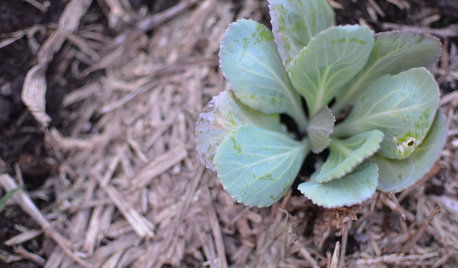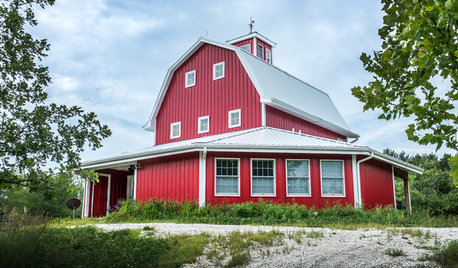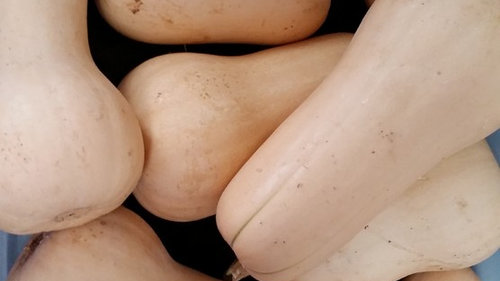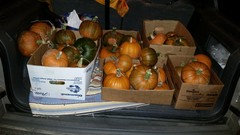Squash harvest and question
luvncannin
8 years ago
Featured Answer
Sort by:Oldest
Comments (25)
luvncannin
8 years agochickencoupe
8 years agoRelated Discussions
When to harvest squash
Comments (16)FWIW, and slightly OT: This is my first year using the Early Prolific Straight Necks. While I am already loving the "Early & Prolific" nature of these, as well as the "magazine photo quality" of them, I do notice that they don't have as much flavor as the crooknecks that I've grown in the past. The zucchini variety that I have is Black Beauty, I believe, and again, I sense that the flavor is lacking. I have another variety in there that's not ready yet...some Hybrid thing that had a mere 6 seeds in the packet, and it's orangey-yellow & white spotted. Am anxious to find out what that tastes like. So take all this with a few grains of salt...the flavor will be better for it ;)...See Morewinter squash harvest question
Comments (1)Leave it all alone until the leaves have withered to the ground and the vines and dead. It will be easy then to find you squashes and you won't have to worry about trashing your vines. But mostly this is usually what it takes to fully ripen a winter squash. If you need a pumpkin for halloween, then sneak in and grab one....See MoreHarvesting winter squash
Comments (7)Thank you for the follow ups. Yes, long term storage is quite important to me. Last year a great many of my squash were not ideal even when not stored long (as stated in the OP, I picked the bulk of the crop on August 15). I resolved to leave 2013 squash on the vine until well into October come hell, high water or an army of critters (in my yard that means squirrels). Some years ago, IIRC, squirrels weren't a problem, but for around 4 years running now, they are a huge problem every year, that in spite of my having deposited two of them in the park ~6 miles away and killing one with a rat trap. I stopped setting rat traps, I've found the squirrels trip them and generally seem unfazed. One time, however, one did die. This year a squirrel (I assume it's only one, but who knows?), has tripped my trap but somehow not been caged. I figure sooner or later I will get him/her, or else the beast will wise up and stop hitting the trap. They do seem clever at times. I'm seriously contemplating buying a pellet gun. I'm curious, is there a way I can configure things so I get emails when someone responds in this thread? I have not seen that in these forums yet, and I did look today when I registered and posted this. I only see something about allowing people to post me directly through email, which I'm not sure about....See MoreWhen to harvest winter squash
Comments (8)No they can't get too big. Anytime frost threatens, time to harvest it all. When the vines are dead or almost dead, harvest (as in your last photo of delicata). When the thumbnail test says the rind is hard you can harvest. Your butternuts look a bit green still, and the plants still have lots of life, so if there is minimal threat of bug or critter damage, more time on the vine would be great. Acorn will have an orange blush on one section when it is ripe. I've read that lifting delicata up off the ground on, say, a plastic coffee can lid to prevent rotting while it ripens is a good idea. Your one scrawny delicata might just be insufficient pollination. I actually disagree with some of what is in that linked article: fine to leave curing squash out doors, just not on the ground (a deck or porch is fine.) Best storage conditions for squash is around 55 and DRY(colder, 40 as they say, not necessary and can actually detract from storage and flavor. This same organization has another article that states this. They are not editing very well.). Also, I would not recommend a garage or basement -- too humid, and that causes rot. A cool bedroom is great. Also, cut or bruised butternut need not be eaten asap -- it normally heals just fine and butternut will not taste it's best until at least 2 months storage. So put the damaged squash in a separate box and watch it closely. If there are any signs of rot, then go ahead and eat it. But I have had deer bitten butternut last until the next June, no problem....See MoreOkiedawn OK Zone 7
8 years agoscottcalv
8 years agochickencoupe
8 years agoOkiedawn OK Zone 7
8 years agochickencoupe
8 years agoAmyinOwasso/zone 6b
8 years agoAmyinOwasso/zone 6b
8 years agoSandplum1
8 years agoOkiedawn OK Zone 7
8 years agosoonergrandmom
8 years agoscottcalv
8 years agoOkiedawn OK Zone 7
8 years agoluvncannin
8 years agochickencoupe
8 years agoOkiedawn OK Zone 7
8 years agoluvncannin
8 years agoOkiedawn OK Zone 7
8 years agoauthereray
8 years agoscottcalv
8 years agoauthereray
8 years agoOkiedawn OK Zone 7
8 years agoscottcalv
8 years ago
Related Stories

EDIBLE GARDENSSummer Crops: How to Grow Squash
Almost foolproof and with cheerful flowers, squash comes in a wide range of varieties to plant in spring
Full Story
Easy Green: 6 Must-Answer Questions Before You Buy
Thinking about buying ecofriendly furniture? For a truly environmentally conscious home, ask yourself these questions first
Full Story
GARDENING AND LANDSCAPINGWorld of Design: 10 Home Gardeners Show Us Their Sweet Summer Harvests
From New York to Tokyo, these gardeners have turned their yards, terraces and rooftops into places of bounty
Full Story
GREEN BUILDINGHow to Harvest Rainwater for Your Garden
Conserve a vital resource and save money by collecting stormwater for irrigation in a barrel or tank
Full Story
FARM YOUR YARDHouzz Call: Home Farmers, Show Us Your Edible Gardens
We want to see where your tomatoes, summer squashes and beautiful berries are growing this summer
Full Story
REGIONAL GARDEN GUIDESMid-Atlantic Gardener's September Checklist
Squash, anyone? Cool-season veggies are suiting up for the garden, while summer's last blooms are winding down
Full Story
SHOP HOUZZShop Houzz: Everything You Need for Fall Gardening
Harvest your garden’s bounty and plan ahead for spring
Full Story0

GARDENING GUIDESOrganic Matters: Thwart Insect Pests With Trap Crops
Add a few sacrificial plants to your garden to lure insects away from the harvest
Full Story
BARN HOMESHouzz Tour: An Energy-Efficient Barn Graces the Nebraska Landscape
Passive-house technologies and a rain-harvesting and greywater system conserve natural resources in this weekend country home
Full Story
HOUZZ TVHouzz TV: How to Make and Plant a Veggie Box
See how to start edibles from seed, then transfer the seedlings to a box on stilts to make harvesting more fun
Full Story






soonergrandmom